
Annenkov Partisan Rifle Brigade
From the beginning about half of Annenkov's forces were infantry, but they are nowhere near as glamorous so are far less well known.
1st Partisan Rifle Regiment
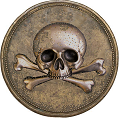 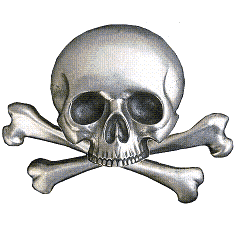 |
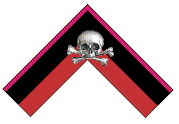 |
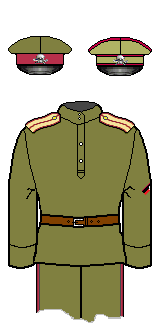 |
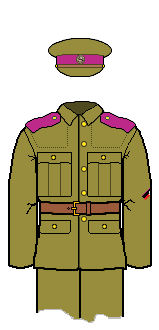 |
|---|---|---|---|
| Cockade reconstructions | Chevron with raspberry piping | Officer with cloth "gold" shoulderboards | Soldier in British uniform |
The 1st Partisan Rifle Regiment was recruited from the very start of Annenkov's campaigns. It was soon joined by the 2nd Regiment, and a rifle brigade was formed.
These two units seem to have stayed together throughout the campaigning. By the start of 1919 there were 1,800 bayonets in the three regiment brigade.
The 2nd Regiment was disbanded in winter 1919/1920, but the 1st Regiment lasted into China.
Shoulderboards for these units are shown at kolchakiya.ru, for both riflemen and the MG sections, as plain raspberry piped in white. The raspberry is standard for Rifle units, but the piping is totally contrary to Imperial practice and seems odd. Plain raspberry seems more likely. It also seems unlikely otherwise identical regiments in a brigade would not distinguish themselves with a cipher : something along the lines of a yellow/gold "1.П.C." would be normal practice for the time.
3rd Composite Partisan Rifle Regiment
Some time in late 1918, perhaps as a result of the the move to the Semirechye, a 3rd "Composite" Partisan Rifle Regiment was added. The name suggests that it was formed by the merging of two or more previous partisan units. While formally brigaded with the other two rifle regiments, it seems to have largely operated independently.
By mid-1919 the 3rd Composite Regiment had 1,880 bayonets and 12 MGs in three battalions, each of 3 companies. There were also 52 bayonets in a scout unit, 44 in a signals unit, and 75 in a training unit.
This regiment found itself in the north when Kolchak's front collapsed in late 1919 and disappears from view, apparently disintegrating or surrendering.
Manchurian-Jäger Battalion
Many infantry divisions in Kolchak's army added a jäger battalion, and it seems Annenkov did so as well. The Manchurian Jäger Battalion appears in the Rifle Brigade for the Partisan Division at the beginning of 1919, which is soon after the move to Semirechye.
The "Manchurian" presumably means it was formed from Mongols, Dzungar or Khalkha, who were a common group in the area, and more especially over in China. (The White partisan units went frequently in China to rest and supply, and seem to have recruited there as well.)
The unit seems to have started being called the Manchurian Horse-Jäger Battalion, then Regiment, in the middle of the year. It also left the Infantry Brigade. Presumably that indicates that it was now largely mounted.
The unit's colour was yellow, which was a standard colour for Buddhist units (Don Kalmyks, for example).
Other Infantry Units
There was a Separate Verkhneuralsk Battalion and a Tatar Battalion, both recruited in the Orenburg area judging by the names. They wore rifle colours, but no partisan chevron, which rather indicates that they were not fully part of the Partisan Division. They seem to have disappeared by 1920.
There was an Engineer Divizion, which seems to have been a combat unit. It was in the north when the Kolchak front collapsed at the end of 1919 and was swept away in the retreat. The Tsarist colours for engineers was black piped red.